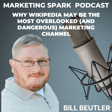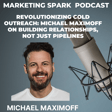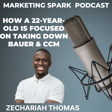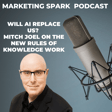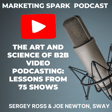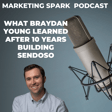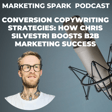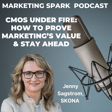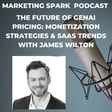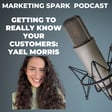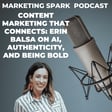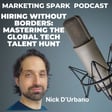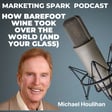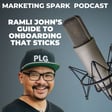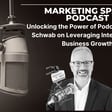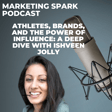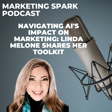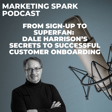Become a Creator today!Start creating today - Share your story with the world!
Start for free
00:00:00
00:00:01

Turn Your B2B Website into a Conversion Machine: Expert Tips from Sam Dunning
In this episode of the Marketing Spark podcast, host Mark talks to Sam Dunning, co-owner of Web Choice, about the common mistakes that B2B companies make with their websites and how to ensure that a website is a conversion machine.
We discuss the importance of planning, messaging, and design when building or relaunching a website.
Sam shares his insights on how to optimize the homepage, product page, pricing page, about page, and call-to-actions (CTAs) on a website.
We also get into the signs that a company needs to redesign its website and where listeners can learn more about Sam and his work.
Transcript
The B2B Marketing Paradox: Great Marketing, Poor Websites
00:00:08
Speaker
One of the strange things about the B2B landscape is companies do great marketing to attract and engage prospects. They deliver value-added content, optimize their SEO, leverage social media creatively, participate in communities, and drive brand awareness.
00:00:28
Speaker
But when people come to their websites, there's a disconnect. Home page messaging is confusing and uninspiring. It's difficult to find information about the product, how it works, and whether it's a good fit. And it's not obvious what someone should do next, such as book a demo or a meeting, download an ebook, or send a message.
00:00:50
Speaker
It's like asking someone to go on a date to a nice restaurant and you show up wearing a stained t-shirt and jeans.
Meet Sam Dunning: Mastering Website Optimization
00:00:58
Speaker
Today, I'm talking with Sam Dunning, the co-owner of Web Choice, which helps B2B companies with websites and SEO. We're going to cover a lot of ground, including ensuring that a website is a conversion machine, which is important as attracting leads becomes more challenging. Welcome to Marketing Spark, Sam. Hey, Mark. Thanks for having me on, man. Looking forward to the chat.
00:01:18
Speaker
Why don't we start with a nice juicy softball question, get you to talk about the biggest mistakes made by companies with their websites. As I talked off the top, there are some really good companies with great products, but their websites are like they cut off their nose despite their face and I always find that confusing and troubling at the same time.
Why Do B2B Websites Fail to Connect?
00:01:41
Speaker
There's an endless list. I could go on for days, but I think one of the most important problems that B2B companies especially make when it comes to their website is that they do not resonate. And when I say that, I mean they do not resonate with their target.
00:01:58
Speaker
client the actual prospects that they want to engage and ultimately most of us especially in the b2b world want our website to act as our best sales rep as our best salesperson because we want it to fuel our sales team with a steady flow of qualified demos
00:02:15
Speaker
consult requests or leads. The mistake I see so often is that B2B companies are just guessing really when it comes to design, messaging, key pages and quite a lot of the time they're just building out these websites around their own ego, around what their marketing team think looks good and what the CEO thinks look good or other execs on the team thinks going to work.
00:02:37
Speaker
rather than actually understanding what their target clients care about seeing, learning, or doing before they're ready to take that next step, book a demo, speak to sales. So that's probably one of the most impactful mistakes where teams are just guessing about what's going to work on their website and hoping for the best.
00:02:56
Speaker
With that answer, you've opened up a can of worms because there's a lot of different places we could go there. But I think one area to explore is really taking a step back and looking at what a company should do when they're considering the relaunch of a website or they're building a website from scratch.
00:03:16
Speaker
What kind of planning should go into a project a big project like building a website and where do they start what are some of the first steps they should take when it comes to launching a website that is going to engage prospects and customers and making sure that it does the job that you wanted to do.
When to Consider a Website Redesign?
00:03:39
Speaker
You probably want to take a step back and think about the why. Why are we redesigning? What are the problems that we're facing that have caused this trigger point that we now have decided that we want to redesign and rebuild a website? Because like you mentioned, it's not necessarily a quick thing. It can take quite a lot of time and resource from your own team or from an external agency.
00:04:01
Speaker
Is it because you're spending a lot on maybe ads, maybe you're investing a lot in SEO, maybe you've got an outbound sales team, maybe you're doing content marketing, maybe you're driving a ton of traffic to your website, but you can physically see that it's not converting those hard-earned visitors into a steady flow of inbound demos or leads. So that's a big issue.
00:04:21
Speaker
Maybe you've had feedback, maybe your sales team have had feedback on calls that your website just doesn't cut it, like they're landing on your site and they don't really understand what you do or maybe they've said, well, it's actually quite difficult to get this job done on your site, i.e. I can't see pricing easily or I found it quite cumbersome to check out your case studies.
The Power of Customer Feedback in Website Improvement
00:04:41
Speaker
couldn't really see some proof of results or it was quite tricky for me to actually make that demo or it was a really long form so you've literally had feedback from the horse's mouth i.e your customers your prospects that there's certain issues that you need to address with your current site or it could be something else it could just be that the website's super update like you built it 10 years ago or five years ago whatever and now your complete business model has changed or your service offerings change and it just misses out vital gaps in the customer journey or
00:05:09
Speaker
or your office. So the main thing to nail down first is why are we doing it? What do we want to get out of this exercise? What are our main goals? Because not every B2B companies want their website to drive inbound. Some don't, some want to use it as a kind of trust builder, i.e. if most of their business comes from word of mouth or referrals, they want people to quickly see like this is the problem we fix, this is how we help, this is some case studies, this is an idea of our pricing, they make it easy for those referred warm leads to get in touch.
00:05:38
Speaker
So think about what do we want to get out of it? And why are we doing it? That's one of the first things. And then you want to think about who is this site for? So who are the target clients that we want to attract, engage, and convert with this site? Kind of really nail down that persona. Quite a useful exercise on that side of things is if you've got a few existing clients, existing customers that
00:06:05
Speaker
fit what you call the ideal persona, perhaps you enjoy working with them. They make good revenue for your company and they fit that kind of client style that you enjoy working with. You can literally sit down with them and if you've got an existing site you can say look what works well about our current site.
00:06:22
Speaker
how do you think our site stacks up against our competitors? What do you feel is missing on our existing website is a really powerful question, because that's the one they can dive into. Oh, actually, you don't have this page, or I thought you could have a better case study here, or you actually didn't dive into this question that I had, et cetera. So there's a literal goldmine just by interviewing some ideal clients or prospects by understanding what doesn't work well, because most B2B companies, if they're established, are already going to have a site. So that's a few starting points. Don't know if you want to dig into that, Mark, before I jump into some more.
00:06:51
Speaker
I'm one of the questions that I'm interested in, it's the classic chicken or egg question, is where does a company start? Is it copy and content for the website or is it design? So it should really be copy and messaging.
00:07:08
Speaker
Because otherwise, whilst you can design pages out, it just makes everyone's life harder. Because if you're building out your homepage, for example, and you're just leaving a couple lines of your headline, and then as the user scrolls down, maybe you've got some images, you've got some examples of your product in play, you've got some social proof, testimonies, et cetera. And you're just kind of guessing how much copies, how much space is there's gonna be. And then when you actually get to writing it out, it just turns out you've got to tweak the design a bit so it can
00:07:36
Speaker
It can save time if you get the messaging right. It means you can design around the message, around the copy. It usually makes sense.
00:07:44
Speaker
One of the things that I struggle with with a lot of clients and things that really trouble me when I look at a lot of websites is messaging, particularly homepage messaging that is uninspiring and confusing. So rather than pull people into the website and start the journey, they actually turn people off. And that's why many of these websites see high bounce rates. And I'm wondering from your experience and the clients that you work with, do they think about
00:08:14
Speaker
Messaging on the home page is it an afterthought is it something that they should a be test i'm just curious about the process and why many companies drop the ball when there's home page message that clearly doesn't work.
00:08:29
Speaker
I would say it's other pages as well, especially when you get into SaaS and B2B kind of detailed complex services that can have a ton of pages around their products, their offerings, their use cases. Those need to resonate because you might be investing in ads and SEO to send people to those. But going back to the homepage, yeah, I mean, it's something we advise clients on all the time because some of the issues I've talked about earlier, really, like sometimes companies are too deep in their own offer.
00:08:56
Speaker
they'll do things like they'll talk about, they'll use technical jargon to describe their offer that their prospects might not resonate with is one issue, i.e. someone lands on your homepage and they just see a headline like, we provide AI tech that improves system workflows and makes a all in one 360 degree experience. And it's like, well, if I landed on that page, I think, what the fuck do you offer? I have no clue what you're doing. And I'll scroll down your page and still be confused and then probably bounce off to a competitor.
00:09:25
Speaker
So that's a major issue and I often say if you're not sure how your prospects describe your offer then you can't go far wrong being super simple i.e. we do A to improve B or we help X improve Y. That's a fine starting point and then once you understand the actual words your prospects use to describe your offer then you can go in a bit deeper.
00:09:45
Speaker
In fact, there's a couple kind of frameworks that I've over the years around homepage headlines. So one is just a simple, we do A to improve B. Another one is you can point out
Crafting Effective Homepage Messaging
00:09:58
Speaker
the enemy in your world. So if there's a monster, if there's a company or if there's something that you absolutely hate, i.e. in our world, SEO might be
00:10:08
Speaker
agencies kind of using sales tactics to try and sell you a massive SEO plan that you might not need. So we might say something like, no jargon, no hard sell, just organic growth for your website or something like simple like that, where you literally lay down everything you hate about your competitors and list out their flaws. But yeah, I mean, the simple, the simplest way to say is with a homepage, if you confuse, you lose. So ultimately you want to be as clear as possible because if someone lands on that homepage, they want to know what you do.
00:10:37
Speaker
how it's going to help them and then an easy way to take the next step, whether it's learning more, checking pricing or booking a demo. Those are some of the fundamentals before you get into in-depth messaging strategies. One of the hypotheses that I have about
00:10:53
Speaker
Bad or mediocre home page messaging is that companies are trying to be all things to all people they don't want to create messaging that excludes a particular segment of the audience that they think they're after so as a result they create messaging that is generic it's very vanilla like as opposed to writing messaging that is.
00:11:18
Speaker
clearly targeted at their ideal customer profile. This product is for you if you have these needs. Do you find that is a problem when a lot of companies are trying to create messaging that they want to appeal to everybody at the same time?
00:11:37
Speaker
Oh, definitely. I think probably 90% of B2B companies do that. 90% of companies in general. I mean, just look at a bunch of B2B headlines, like so many of them just say award-winning, best in class, we just got funding, G2 top rated.
The Pitfalls of Generic Messaging
00:11:51
Speaker
It's like, you see that 99% of the time, it just goes over your head because it's so vanilla. But when you actually, like you said, Mike, when you drill down into this is the segment we help, this is how we get them results, this is the specific pain point we fix around our offer,
00:12:05
Speaker
it helps resonate and it also means if you're driving traffic, if you're doing like targeted LinkedIn ads, if you're doing target Google ads to the specific niches and industries, when they land on something it's more likely to resonate because you're directly speaking to the pain point that target market has or you're directly speaking to maybe the goal that they want to achieve or the issues they're having around revenue, whatever. So the juicier you can be the better
00:12:29
Speaker
And also, do you wanna attract everyone and anyone, especially when a lot of B2B companies have high ticket offers? So if you're just attracting like a bunch of prospects that don't fit the right persona, I mean, what's to say, they're not gonna have cash to invest in your offer, they're not gonna be the right fit and all these kinds of problems that might cause?
00:12:47
Speaker
I have a client that is struggling with attracting leads. The problem is they're getting a lot of tire kickers or getting people who are not the ideal customer. They don't have the budget, they don't have the needs, but the marketing attracts them and they get to the website and they fill out the Asper demo form and it turns out
00:13:08
Speaker
they're not really the type of customer they want. I think it has a lot to do with their home page messaging. I watched a YouTube video in which you talked about the seven must-have pages on a website. Can you quickly run through these pages? And then I'd like to drill down into best practice for a few of them, particularly home about pricing and contact, which I see as the key pages, but in many cases there are
00:13:32
Speaker
Some of them are afterthoughts and some of them just aren't well-designed and structured. So why don't you talk about the seven must-have pages and then we can explore some of the pages that I think play a key role.
00:13:42
Speaker
Yeah. Yeah. So I wrote an article and did a video, like you said, a little while back. And in my opinion, this was basically after, because I run a podcast too called business growth show. And just like yourself, Mark, I've interviewed a ton of kind of VP, CMOs, B2B companies, and assessed like our own website to get an idea of what pages on our own sites, on client sites, on prospect sites, basically get most visited. And people actually care about usually.
00:14:08
Speaker
When someone lands on your site, they essentially wanna get a quick idea of what you do, problem you fix, how you're gonna improve their life or improve their business or get them certain result that they care about. And based upon the fact you quickly do that with your homepage, and they're probably gonna flick to case studies or results, check out, you can do what you claim you can, maybe look at some customer video testimonials, look at some reviews on G2, CapTear or whatever.
00:14:33
Speaker
Then check out, they can actually afford what you do. So they're gonna check out your pricing's within their budget. So if you're a SaaS offer, you've probably got three tiers. If you're a service offer, perhaps you say, look, this type of service starts at this rate, this type of service starts at this rate, and this one's at this rate.
00:14:48
Speaker
And then on the basis that you check all those boxes, as long as it's easy for them to speak to sales, like book a demo or book a console, whatever that CTA is, then they're probably going to get in touch if you fulfill all those boxes and have a website that does the basics right, i.e. decent load page time design that's actually engaging and attracts them and messaging is right. But I think you're asking for some of those specifics around the pages, right?
00:15:14
Speaker
Yeah, why don't we start with the homepage? Because obviously, it's the page that attracts the majority of website traffic. And we've talked a little bit about homepage messaging. Get a little deeper into the role of the homepage. Because I think in many cases, people are trying to get a sense of the whole story when they visit the homepage. They may not click deeper. They may click into a couple of other pages. But in many cases, the homepage is the page where they find out what the company does and whether it's relevant to them.
00:15:44
Speaker
Can you talk about what that page needs to have on it so that it gets people into the consideration funnel? Get them thinking about maybe this is the option for me. Maybe I should click on that button so I can book a demo or reach out to somebody.
00:16:00
Speaker
Just some high level best practices is that above the fold on your homepage, so as soon as someone lands on your homepage, above the fold means before someone scrolls. But if we go from top down, you want your fixed menu nav, it's going to have your key pages like home about, services drop down, resources, contact, and then usually top right you've got a fixed CTA, fixed call to action button, maybe that's book a tailored demo, speak to a sales engineer, whatever's relevant.
00:16:27
Speaker
and usually under that you've got what's called a hero area or a top banner area and that's usually got your homepage headline where you describe this is the problem we fix this is how we improve your business or this is how we're different then you maybe got a couple call to actions like
00:16:41
Speaker
book a demo or view pricing or see proof of results. I normally encourage companies to have two call to actions there. So for example, in ours, we've got like view our work and then next to it is book a call, something like that. And then you've got people, give people the option to see the results or if they're ready, speak to self straight away.
00:17:00
Speaker
and then these days you want social proof above the fold still so that might be sliding testimonials that might be we've helped this many brands succeed that might be some recent logos you've worked with etc loads of options you've got one social proof
00:17:15
Speaker
And then you've got to remember that it's very, very rare that people scroll right to the bottom of your homepage. So you need to pack as much value in that above fold section as possible, like I just mentioned. So really letting people understand your value prop and showing that you've done it for others.
00:17:30
Speaker
And then as they scroll down, you might dive deeper. So if you're a software tool, you might show screens of the key things that people care about around your software tool. You might say, look, this is for a sales enablement tool, like this is how we can improve your sales process quick, like three times quicker than doing it manually, whatever, and then dive into a screen.
00:17:49
Speaker
So basically as people go down a bit further along the folder understanding a key value prop maybe you've got some more social proof maybe we've got some more video testimonials etc as people scroll down but remembering the further and further you get down the less likely people are to see it so you've got to jam as much value in.
00:18:04
Speaker
above that folder as possible and also a lot of companies still forget to make their menu sticky so what I mean by that is on mobile and desktop as you scroll your menu should still be fixed at the top of the page so people can easily access your menu nav to pages and also click that main call to action if they want to book a demo or live chat or whatever that is.
00:18:23
Speaker
So that's like homepage, and I think you're asking like, in my top seven pages, it was home results, case studies, or pricing was the next one, third one, then service pages, about page, contact page, and thank you page is my top seven, but happy to dive into any of those a bit further.
00:18:41
Speaker
You mentioned that you want to tease at the product on the homepage. You want to give people a sense of what this thing looks like. When somebody does actually click into the solutions or the product or the platform page, they come with different names. What do you want to show them? Obviously, you want to give them a sense of the experience.
Product Pages: Engaging Through Features and Pain Points
00:19:00
Speaker
You want to highlight
00:19:02
Speaker
the key features, but you don't wanna make it a laundry list of everything they can do with the platform, because obviously that's not gonna be terribly inspiring, and they can learn that if they ask for a demo. So what should be on the product page to get people excited about what's possible? And I love that term, what's possible, because you wanna tease people, you wanna make them curious, you wanna get them excited about how their jobs could change if they use this product. So what does that page look like?
00:19:31
Speaker
It's like a great demo, right? So the worst demos I've ever sat on personally is where sales rep just talk about how great their product is for an hour. They don't ask any questions about your current state, the problems you're facing today, where you are now and where you want to get to in six or 12 months. Those kind of sales calls are painful, right? It's a lot better when it's a two-way conversation and they're addressing your pain points and your goals.
00:19:55
Speaker
websites are much the same. So if you're going to share your tool, bring up the things that people care about first. And that's where customer research comes in, because then you understand like these are the top three pain points people want to fix. Let's straight away say, look, we understand this is your problem. These are the three main screens, for example. And these are the top three high level features that are going to directly address these pain points. And then if you want, which a lot of SAS tools do, they get into each individual use case.
00:20:22
Speaker
So like they might have a drop down for services or use case and then you could say like if you serve manufacturers, IT companies, et cetera, you're listing each use case. So if people do want to get into nitty gritty, they can do so, but on your high level overview, you're addressing directly those pain points in the top three or so features with screens.
00:20:42
Speaker
And some sites now are even doing live interactive demos on their site, like they're actually letting people see the video demos there. So if people don't want to speak to sales right away, they can actually view a quick video demo.
00:20:55
Speaker
The other page that you mentioned that I'm always curious about is the pricing page.
Pricing Transparency: Building Trust and Quality Leads
00:21:00
Speaker
And when I hit a B2B SaaS pricing page and the prices aren't listed, first of all, my first reaction is what are they hiding? What is it about their prices that they don't want to show people because maybe they're very high. Maybe they're afraid of displaying competitive information.
00:21:23
Speaker
So what are your thoughts on the pricing page and what does a company show on that page other than prices and a few, here's what you get, a menu of here's what you get for this particular package.
00:21:35
Speaker
To be fair, I think a lot of SaaS companies are actually better at this than technology, more custom technology companies, service companies. A lot of those companies are just scared stiff to share their pricing. Yet when you speak to their sales team, they'll tell you, yeah, we're speaking to tire kickers like all the time. We're just wasting our time on these leads that can't afford what we do. I've had arguments of like people that marketers at zoom in for like Cognism and famous companies because they're not doing it.
00:22:02
Speaker
I'm sure their sales team if I spoke to them they'd tell me yeah we get a bunch of tire kickers all the time. Now the reason that pricing pages are probably one of the most impactful pages when done right that a B2B company can do is because yes if you're a SaaS company you've got three tiers it's simple to show pricing A, B, C and then maybe have a high level
00:22:24
Speaker
quick few points on the most common features people actually care about. If you're a service-based company, it gets you a bit more difficult, that's when you probably want to give a range, i.e. we do a silver tier, it's between 5 grand to 10 grand, we do a gold tier between 10 to 20 grand, and we do a diamond tier between 20 to 30k as an example, and then you list again the core features. But the good thing about not only sharing pricing is going to qualify prospects,
00:22:51
Speaker
in terms of do they have cash to actually be able to work with us. But then you can back up your claims. So as people are scrolling through that page, you can use custom interview videos. This is a customer we had with a similar pain point. This is the problem they came to us. This is why they chose us. This is why they invested the money. This is how their life and business has improved the result of working with us. You can also use testimonial sliders. You can use brands worked with.
00:23:17
Speaker
And you can answer common questions on that page around pricing. Literally like why are you so expensive? Why are your competitors cheaper than us? How long does integration take? Do I get a dedicated account manager?
00:23:30
Speaker
what are renewals like? Am I locked in on a contract? So all those questions that your sales team are literally getting on a day to day, address them directly. It's gonna make prospects less skeptical. It's gonna show transparency and it's gonna feed your team better qualified leads, thus saving you time and your prospects time.
Rethinking the About Page: Focus on the Customer
00:23:49
Speaker
The last page that I want to dive into is the one that I spent a lot of time thinking about. I recently wrote a series of posts on LinkedIn about it and that's the about page. What triggered my LinkedIn posts was visiting this about page for a very cool company. What I want to know right away is what you do and whether you're relevant to me. Instead, I got this creative. Our company has cool people working for it. Frankly, I don't care about your cool people. I don't care whether you have
00:24:17
Speaker
a cool office, what I care about is me and whether what you do is going to help me drive my business forward and is going to make my life easier in terms of the jobs that I have to do every day. So what are your thoughts on the about page? What does it need to do? What are some of the key elements that need to appear on it?
00:24:35
Speaker
I think the about page is a good one because if you look into your analytics, like if you've got Google Analytics on your site, it'll probably surprise you how many people visit it. Up until a while, our own about page was the second most visited page after our homepage. Now I think it's like homepage pricing and then about, which is still like a significant amount of traffic and a lot of websites will have similar. And if you've just got, like you said there, your about page is like,
00:25:01
Speaker
Oh, we're award-winning. We've been in business 30 years. Like, here's our team, here's our dog. And we're like a really creative company. It's like, who cares? I often advise companies to share maybe a brief snippet about the founder story, why the company was set up and what other got motors behind it.
00:25:17
Speaker
get to the point about the problems that you fix i.e typically we work with this type of business that's struggling with this or frustrated about this and they want to improve these results so that should be kind of above the fold content and then i usually advise businesses to direct to something relevant so maybe we've got a call to action like view some case studies here's some recent work we've done or here's some clients we've helped that struggled with these problems here's our useful resource i.e a recent article on this or here's our podcast where you can learn more about kind of what we do and get some free tips
00:25:47
Speaker
the niche that we serve and then maybe later on if you do want to put some key team members like the accounts, not the accounts team, like yeah, I don't know, the customer service team, the tech team, whatever, that's fine. So those are the few of the points that I normally advise. So really, like you said, making it about what's in it for the prospect, rather than how great or awesome your own team is.
00:26:09
Speaker
The other area that I wanted to talk to you about, and this is sometimes the most contentious or the most controversial, is CTAs.
The Importance of Effective Call-to-Actions
00:26:17
Speaker
Great website, great messaging, easy navigation, all the good things that you want on a website. And then people don't see the CTAs. They're not as obvious as they should be. Or the CTAs are unidimensional, ask for a demo.
00:26:36
Speaker
or the CTAs are just buried in the bottom of a page. And so you do all this great work and then people don't convert because you're really not telling them what they should do next. What are your thoughts on CTAs and as important, what are some of the alternatives to the classic B2B SaaS CTA of Ask for a Demo?
00:26:57
Speaker
Yeah, CTA is a funny one because like you say, probably 99% of SaaS companies have requested a demo or book a demo. And I don't necessarily think there's anything wrong with that. I mean, CTA best practices, like I said, is homepage above the fold. Most information pages, you want it above the fold and then you want it stuck in your sticky menu nav on mobile and PC. You probably want it a standout color and you probably want it fixed to the top right. So no matter where someone is on the page, they can easily access it.
00:27:23
Speaker
Now with that aside, descriptive call to actions are good, i.e. if you describe the exact action that a prospect might take and what the outcome will be as a result of clicking that, but only if they're actually relevant to what your prospects describe your offer as, or what they describe they want to do, i.e. if the first stage of your process is booking an audit,
00:27:45
Speaker
maybe that makes more sense than booking a demo. I book your tailored audit if you're more of a complex offer and it's not like we're going to show you a screen share on day one because that's not relevant because we've got a really complex B2B product or service here and we need to probably need to run an audit with you first.
00:28:02
Speaker
So what is it that prospects actually ask you for on sales tools? How do they refer to your service? Then maybe consider putting that in your CTA as the first step. That's something I usually advise. And then you can test it. If you've already got a decent amount of traffic coming to your site, perhaps you test a CTA on a certain amount of pages.
00:28:21
Speaker
And if you find that it drops a lot after you change it from demo to something else, you might want to switch it back. Whereas if there's an uplift in click through rate, then maybe you can tell it's working well. So there's nothing wrong with testing those things. Something that I see a lot in terms of an issue is kind of decent demo pages or contact pages. So a lot of the time,
00:28:40
Speaker
the actual pages businesses use to capture details are poor, i.e. you don't have your contact form or your demo form or your calendar form above the fold, instead you've just got a load of info about your company and then someone's got to scroll right to the bottom of the page. I mean some simple best practices around the demo page or the contact page itself is you can remove menu nav so there's no distraction,
00:29:01
Speaker
you can straight away have like book a call with our sales engineers or whatever that line is, maybe a calendar there or a simple form where people can put their details in and then backing up with social proof because some people might be anxious around what happens next so maybe you've got a customer review video or some testimonials, maybe underneath it you've got some FAQs around what happens after I book some time like
00:29:23
Speaker
explain the actual process after sales, after someone books a sales school. And then another often neglected page is the thank you page. So when someone actually takes the time to book time on your team's calendar, then actually saying, well, thanks very much. If it's a calendar, we'll be in touch to arrange the time or if they've already booked it. Here's some links to some useful resources, podcasts, video articles, et cetera.
00:29:44
Speaker
Sometimes you book a demo or contact, consult request on a page and the page just refreshes and you're not actually sure if anything's happened. You're just bamboozled like, will they get in touch? Will they not? Whereas if you have a clear thank you page, it just clears everything up and makes prospects excited to speak to your team if you give them some useful resources and kind of show that you're, how quickly you're going to be in touch.
00:30:04
Speaker
If you had to pick one widget when it comes to Book a Demo, would it be a calendar widget in which somebody picks a time and day to talk to you right away, and you get some details about what they're looking for, so you can use Calendly or TidyCal? Or would it be the contact page where they fill out the form, they do all the work themselves, and then they expect you to get back to them with details about when a conversation could happen? Or is it both? I think, generally, calendar time.
00:30:35
Speaker
Now I'm speaking to established B2B companies that have a sales force because then you can use a tool like Calendly or Chili Piper and then you can instantly book the time that suits you and that gets routed to the relevant sales rep. So if you've got a team of sales reps, then that is a no brainer. Now, if you're a smaller company, you're gonna respond to people quickly. You don't necessarily need that. You might just have a contact form and then you'll be, as long as you contact them like within an hour or so of the contact form, you can get away with it.
00:31:03
Speaker
Yeah, if you're an established company with a lot of sales reps, you need a calendar tool. It's like a no-brainer. One final juicy question is we've talked a lot about best practices for website, website design, website content. What are the signals that a company gets that it needs to redesign its website?
Recognizing Signs for a Website Overhaul
00:31:23
Speaker
Something's not working. The website isn't doing the job that it's designed to do and they have to take a step back and refresh or rebuild the website.
00:31:32
Speaker
So a few of the things we talked about at the start already, if you're getting feedback on sales calls, prospects are saying things like, your website, I couldn't find this info on there, I didn't understand really what you did, it's missing this page, perhaps they're saying competitors are doing a lot.
00:31:48
Speaker
Yeah, when you're getting those kind of really signals that you do not want to hear, I couldn't find this, didn't know what you did, couldn't see this, this was difficult to find, that's a telltale sign that something, not necessarily redesign but something needs work. So that's definitely a red flag or probably the worst one is if you're investing
00:32:06
Speaker
cash or resource from your own team or external team into advertising or marketing, whether that's SEO, LinkedIn work, LinkedIn ads, paid ads, paid search, webinars, et cetera. You're sending all this traffic to your site and you're pretty sure it's coming from idle clients like the channels they hang out on, but it's just not converting effectively, then that's when you're gonna need to have a look at, assess your website, dive under the hood of it.
00:32:32
Speaker
Start interviewing prospects. Start looking at your analytics. Is there a huge bounce rate on the homepage? Okay, something doesn't hit right. Maybe we've got a poor load speed. Maybe our homepage messaging doesn't resonate. Maybe it's difficult for people to get in touch. Maybe people don't trust us quickly enough because they're not seeing social proof. All these things you've got to assess and analyze and then make sensible decisions based on data. One final question is where can people learn more about you and what you do?
00:33:01
Speaker
If you're in the market for free B2B website and SEO tips, then connect with me on LinkedIn. It's Sam Dunning. I post stuff every day. Otherwise, I've got a podcast business growth show where I post a bunch of tips and interview B2B leaders. Or lastly, if you're perhaps a bit frustrated that when idle clients are searching for what you do on Google, but your competitors are above you, stealing traffic and opportunities, or if you feel like your website isn't converting effectively those hard earned visitors into a steady flow of inbound,
00:33:30
Speaker
then give us a shout. It's WebChoiceUK.com. Awesome. Well, thanks, Sam, for all the great insight. We've put the spotlight on the fact that websites are designed to do jobs. They drive conversions. They educate prospects and customers. And if they're not doing that, then you've got a major, major sales and marketing problem. So thank you for answering all these questions, including some of the softball questions that I asked. And thanks for
00:33:55
Speaker
listening to another episode of Marketing Spark. If you enjoyed the conversation, leave a review, subscribe via Apple Podcasts, Spotify, or your favorite podcast app, and share via social media. To learn more about how I work with B2B SaaS companies as a fractional CMO, strategic advisor, and positioning and messaging consultant, email mark at markevans.ca or connect with me on LinkedIn. I'll talk to you soon.
